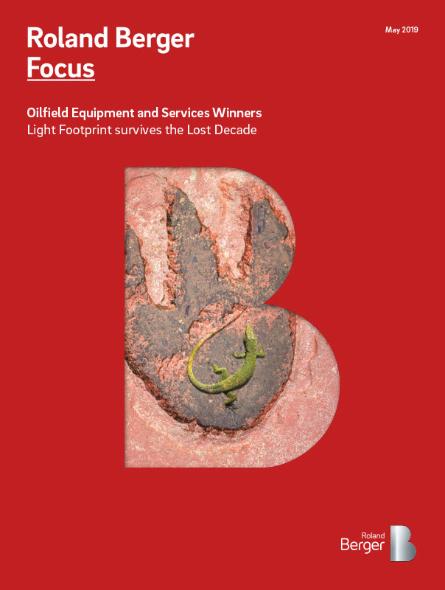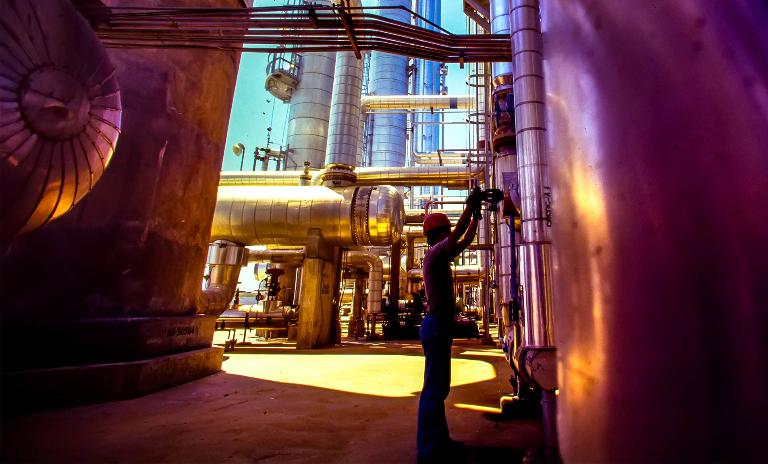Oilfield Equipment and Services industry: A year with highs and lows
![{[downloads[language].preview]}](https://www.rolandberger.com/publications/publication_image/roland_berger_507_ofes_winner_cover_download_preview.jpg)
2018 was a mixed year for Oilfield Equipment and Services (OFES) companies. Meanwhile, Light Footprint survives the Lost Decade.


2018 proved to be a rather mixed year for companies engaged in the Oilfield Equipment and Services (OFES) sector. Even though oil prices rose in the first nine months due to strong demand and positive geopolitical developments, rates plunged by almost 40% in the last quarter — accompanied by fears of an economic slowdown in the wake of serious turmoil in the financial markets. At the end of 2018, the barrel price had dropped to 51 U.S. dollars (USD/bbl) — lower than at the beginning of the year. This is the conclusion of a Roland Berger study entitled “Oilfield Equipment and Services Winners: Light Footprint survives the Lost Decade”.
According to the study, the total turnover of the 179 companies surveyed rose by a solid 8%, as the average oil price reached 71 USD/bbl (2017: 54 USD/bbl). Adjusted for currency effects, this represents a growth rate of 25%. However, in terms of growth in invested capital - i.e. the sum of borrowed capital and equity — the industry shrank by 5% as compared with the previous year. This was primarily due to the slump in working capital — the difference between current assets and current liabilities — in the fourth quarter. Overall, working capital fell by 2 percentage points and to 19% in 2018.
Despite a slow growth in sales, the EBIT margin of OFES companies also improved last year from 6% to 7%. Meanwhile, the ROI Capital was still negative across the board at -3%. Regional diversified players showed the worst ROIC performance over a three-year period with -6%, while category killers delivered the best performance, yet still lost money at 1%. Considering risk-adjusted profitability (after netting WACC out of returns), the industry went significantly into the red with average industry-wide spread amounting to -13%. Still, 16% of companies (29 companies in total) generated returns over the cost of capital, 4 percentage points more than the previous year.
Meanwhile, the total debt of the 179 companies analyzed by Roland Berger fell noticeably by USD 8 billion in 2018, which corresponds to a decline of approximately 3% compared with the previous year. Combined with a rising EBITDA level, this resulted in an improved ratio of debt to EBITDA. Nevertheless, the ratios were high compared with the previous year.
Returns were negative: From a total shareholder value (TSR) perspective, the industry achieved returns of -26%, well below the S&P 500. The S&P 500 index comprises the shares of 500 of the largest US-listed companies and is one of the most highly regarded stock indices in the world. IN 2018, it fell by -6%.
Overall, it can be said that the prolonged oil price downturn has created a new era in the OFES industry. Oil prices are expected to remain lower for an extended period of time, as any changes in either supply or demand can be almost immediately addressed either by OPEC or players in the North American shale market. Cycles are getting shorter, with lower volumes than before, as the shale system is able to respond quickly to OPEC structures. This phenomenon has become evident in the last couple of years, with a short oil price uptrend followed immediately by a short downturn now observable every year.
Of the companies that were successful in the past three years, two distinct groups can be identified: The first group of players consists of “Financial Engineers”, who took advantage of the efficiency of well-functioning North American/ European capital markets, to lower their asset cost base, either by restructuring their balance sheet or by acquiring bankrupted or near-bankrupted assets for a fraction of book value.
A second small group of market participants, described as “Light footprint companies” is even more interesting. The players in this group were able to change their business model as well as their mindset to pursue a successful strategy in the future industry environment. They followed three core ideas. These include redefining roles within the organization and investing in people to create an agile and adaptable set-up with fewer resources, lower costs and flat organizations, in addition to embracing digitalization and automation through tools and technologies (both hardware and software) that increase productivity and efficiency. These two ideas are complemented by changing culture and mindset to embrace a learn & test mentality.

![{[downloads[language].preview]}](https://www.rolandberger.com/publications/publication_image/roland_berger_507_ofes_winner_cover_download_preview.jpg)
2018 was a mixed year for Oilfield Equipment and Services (OFES) companies. Meanwhile, Light Footprint survives the Lost Decade.
